



When you have successfully completed this section, you will have mastered the following:
One of the most important features of a vehicle electrical system is the lights. They have evolved over time becoming reliable and efficient parts of the safety equipment and they are found on almost every type of vehicle.
A look back at the history of vehicle lighting
It was early in the history of self-propelled vehicles that people recognized the need for lights. It was clear that if vehicles were to be operated close to dawn and dusk, to say nothing of nighttime, some type of lights would need to be used. An early answer was to have a person with a lantern run along in front of the vehicle both to light the way and warn people in its path. Soon after, lanterns were simply hung on some convenient projection.
The first real on-board application was oil-fired lamps like those used on the railroads. Carbon arc lamps were used in some cases as horseless carriage makers experimented with all kinds and styles of lights. But they had to have their electrodes replaced every few hours, which made them inefficient and inconvenient and often temperaental. They were, however, much brighter than an oil lamp of the same period.
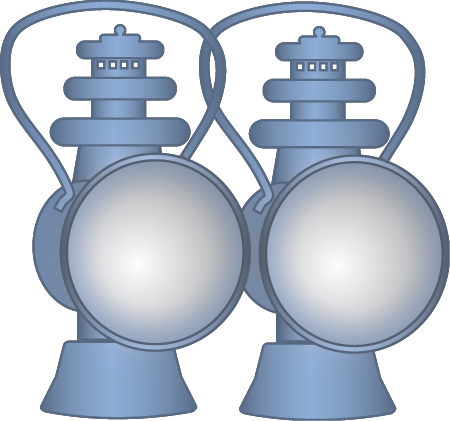
Early headlamps were kerosene powered.
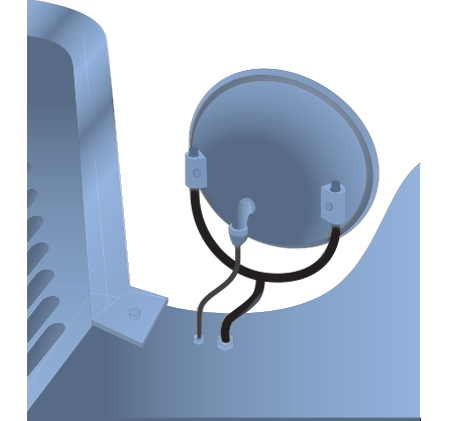
The first electric headlamps were used on automobiles prior to 1910.
Lanterns rapidly led to acetylene gas headlamps that used parabolic reflectors to concentrate more light in front of the vehicle. It wasn’t until 1908 that development of modern vehicle lighting began. It was about that time electric bulbs found their way into motor vehicles. In an interesting approach to reducing glare for oncoming automobiles, the driver of one early model could manually tilt the headlamp by using a cable that ran from the headlamp to the driver. By 1915, red rear lamps and yellow brake lights were introduced. (Since that time, brake lights have been changed to red.)
After the incandescent lamp was invented, it took a great deal of tinkering to make it give off enough light using a six volt system or whatever other low voltage system the car-maker decided to use.
In headlights, also referred to as “forward lighting,” the first really innovative development occurred in the early 1920s. It came in the form of the dual filament or “Duplo” brand lamp. In the early 1950s, the first lamp with a low beam and a high beam in a single sealed housing was introduced. It was called the “Duplo-D.”
In 1938, the incandescent sealed beam lamp was introduced and became a major step toward longer-life lighting. The new “sealed” lamps provided much greater protection for the filament and prevented the weather from damaging the lamp.
However, despite this major step forward, the sealed beam remained an incandescent light source, subject to varying brightness and life limitations.
Sealed beams are manufactured as a completely sealed lamp assembly which plugs into a socket arrangement of a vehicle. Typically, a sealed beam used as part of a forward lighting setup contains both a high beam and a low beam component.
Since the filaments are sealed completely inside the lamp, there is no way to replace the individual components. When the unit fails, it must be replaced.
Because they are factory-sealed incandescent lamps, sealed beams also share many of the shortcomings of other incandescents. For example, they are sensitive to vibration and elevated voltage levels.
Years went by before the next big development in forward lighting, the single-filament halogen bulb, available in Europe in the mid-1960s. It was new, longer lasting, took less energy than incandescents, and provided 50% more light. Dualfilament halogen lamps developed in the 1970s are used today in most US cars.
Prior to 1975, US headlights had to be round, non-halogen, U. S. Department of Transportation (DOT)-approved sealed beam units. They had to consist of two large dual-beam bulbs or four small- er single-beam units. After 1975, the DOT allowed rectangular sealed-beam bulbs, using the same layout as the round ones. In 1985, as pressure from consumers and automakers increased, the DOT adopted its current lighting standard, which allows for halogen lamps and “non-standard” headlamp shapes.
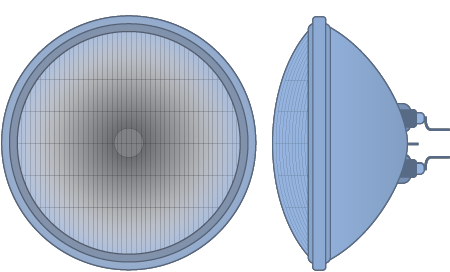
Round sealed beams were standard equipment for many years. The bulb, reflector and lens were all sold as a single, sealed unit.
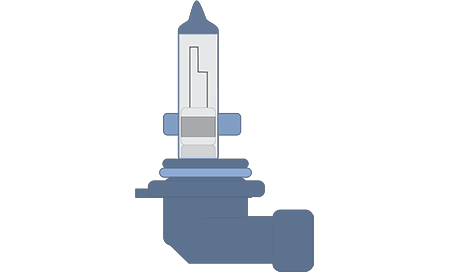
Today, most cars use halogen bulbs.
Advances in forward lighting
Halogen has replaced the duller and less efficient, ordinary incandescent lamps. Halogen produces a whiter light that makes objects appear closer to their true, natural color. Compared to the warm yellow cast of incandescents most drivers prefer halogen. Halogen lights also last longer and deliver more consistent performance under variable conditions.
In some ways, halogen is similar to incandescent but out performs them by a wide margin. Basically, a halogen lamp has a small amount of halogen gas added to the iodine, bromine, chlorine and fluorine mixture in the clear shell. Then when the filament begins to lose tungsten by evaporation, it combines with the halogen. But when it cools down, the tungsten is redeposited on the filament. Because of this recycling, the life of the filament is dramatically extended.
That’s why halogen, compared to various incandescent sealed beams, is known for its relatively long life and greater light output of whiter light.
And, there are no blackened bulbs to rob performance. It also operates in a higher temperature range.
However, halogen is more expensive than incandescent.
An offshoot of the halogen lamp is the so-called HIR, which stands for halogen-infrared. It consists of a specially shaped halogen lamp, which has a coating on the glass that reflects infrared radiation back to the filament.
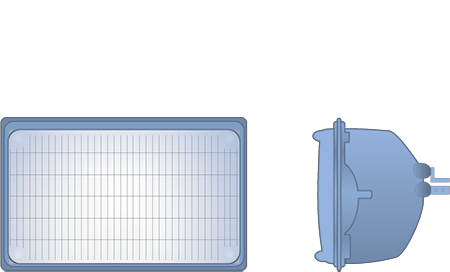
Rectangular sealed-beam began to appear after the DOT legalized them in 1975.
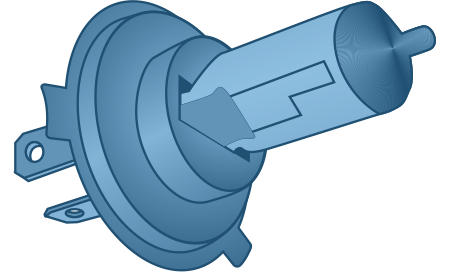
When a halogen bulb begins to cool down, the vaporized tungsten is redeposited back onto the filament. This results in increased bulb life.
The result is a more efficient light output than ordinary halogen. It also generates an even whiter light. However, the lamps are more expensive and they run hotter.
Another relatively new development is the High Intensity Discharge or HID lamp. It is designed to improve safety, improve lighting system performance and provide a light source that would last for the life of the vehicle. It was first introduced in the European market in 1991. HID was first seen in the North American market on the 1996 Lincoln Mark VIII.
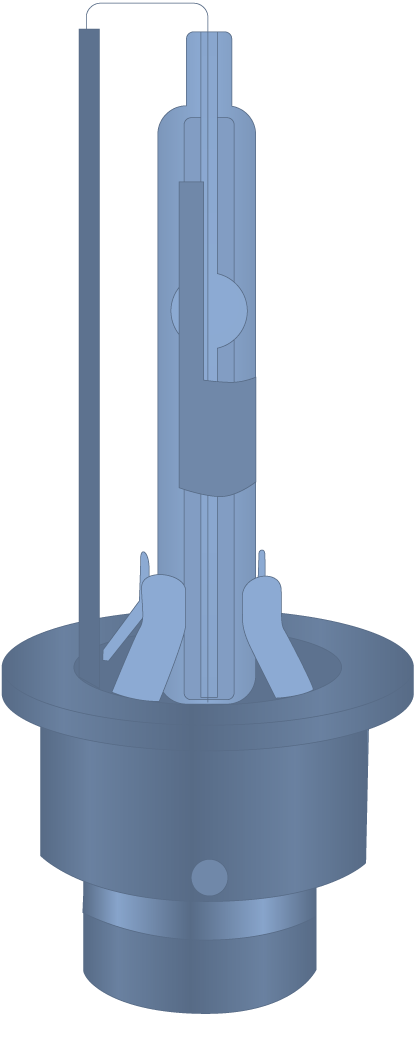
High Intensity Discharge (HID) lights are designed to improve vehicle safety and last for the life of the vehicle.
HID was a significant advance in automotive lighting technology. HID doesn’t employ a filament. Instead, HID bulbs generate light by creating and sustaining an electrical discharge between two electrodes in a small “arc tube.” In operation, the electrical discharge excites a mixture of xenon gas and mercury that forms a brilliant white light, much closer to natural sunlight than halogen lights. HID generates up to three times the light output of halogen while using less energy.
Another feature of the HID system is that it requires ballast to start and run. The reason is that the starting voltage is approximately 20,000v, which drops to 200v and then stabilizes to run at approximately 80v.
There’s no filament to degrade or break, so light output is more constant over time and HID systems can last up to 10 times longer than today’s standard halogen lamps.
HID is a very efficient system and has a long life... about 2,000 -3,000 hours. However, even though the HID lamp doesn’t “burn out,” it will gradually dim over time. Compared to incandescent, it is less affected by vibration.
Because of enhanced peripheral vision and improved down-road illumination, HID is quickly becoming popular with drivers. Over time, as HID technology spreads and costs are reduced, HID will make greater penetration into mainstream vehicle applications.
On the downside, HID systems are still relatively expensive. They require very high voltages to start and they run at high temperatures.
Other types of vehicle lighting
The technology employed in taillights, stop- lights, interior lights and other vehicle lighting was relatively slow to develop. In fact, incandescent bulbs were virtually the only technology system used up until 1990.
Today’s incandescent is a direct descendent of the original concept. It typically consists of a base with electrical contacts, a glass enclosure or bulb and a filament wire (typically tungsten) that is sus- pended inside the bulb. Incandescents can have one or multiple filaments in the same bulb.
The filament is part of the electrical circuit. As current passes through it, the wire heats up due to the resistance in the tungsten. When the current reaches a certain level, the filament begins to glow a dull color. Add enough current, and it will glow “white hot.” Unfortunately, in order to operate, incandescent bulbs waste 95 percent of the energy flowing through them as heat.
If used in an atmosphere containing oxygen, the filament would quickly begin to combine with the oxygen and deteriorate. The result of that combi- nation, corrosion, would promptly cause the lamp to fail. To prevent or slow the process, the bulbs are filled with an inactive or inert gas that doesn’t combine with the filament.
Filaments used as part of incandescent vehicle lighting are typically found in three styles. It may be a straight wire, a single strand that reaches directly from one support across to another.
Common Incandescent Bulbs

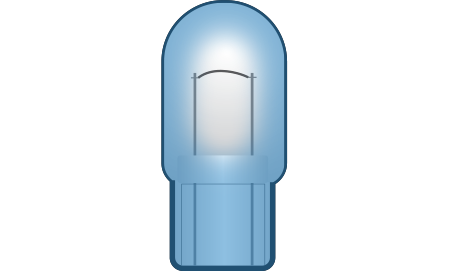
Another style is the coiled filament, which has a conductor that is coiled and reaches across from one support to another. The coils provide a means of increasing the amount of filament surface area to produce more light, while concentrating the light.
It also provides a spring-like action to help cushion the filament from vibration. The coiled filament is the most common type found in vehicle lamps.
A variation on the coiled filament is the coiled coil. With it, the filament wire is tightly coiled and is then wrapped again into the normal coiled shape.
Incandescent lamps have been around for many decades. They still have attributes that make them a good choice. They are relatively inexpensive to acquire and use. They are also readily available from a myriad of sources including, in some cases, grocery stores. Incandescents are available in a wide variety of sizes and styles.
On the other hand, they have a short life when compared to newer technologies. Vibration has a damaging effect on them. And over time, in many incandescents, the inside of the glass bulb becomes blackened by an aging filament, cutting down the light output.
Incandescent lamps are particularly sensitive to voltage that varies even slightly above the norm. Operating an incandescent light at just 5% over design voltage reduces the life of the bulb by 44%. At 10% over design voltage bulb life is reduced by 68%.
Light Emitting Diodes (LED’s)
The most important improvement in non-forward lighting has been the advent of light-emitting diode (LED) lamps. LED’s are semi-conductors, which allow current to pass through in only one direc- tion. As the current passes through a crystal chip, it jumps from a negative plate to a positive plate, and as it does so, a “photon” (light) is generated.
The light emitted by an LED is directly proportion- al to current passing through it. LED’s can produce light in many colors, for example red, green and amber. A recent development was the advent of the clear or colorless LED.

Straight Wire Filament
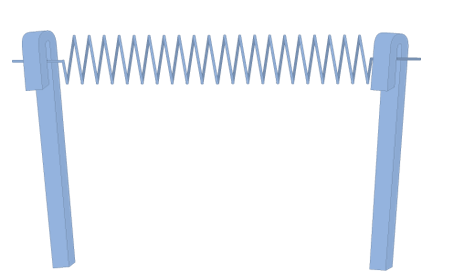
Coiled Wire Filament
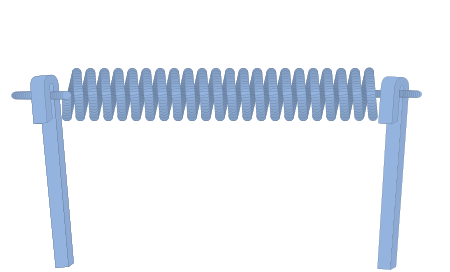
Coiled Coil Filament
LED’s supply a high level of illumination for vehicle applications. They make very efficient use of the electrical energy that powers them, signifi- cantly better than the traditional incandescents they replace and they run much cooler and don’t “age” due to heat build-up. They start producing light the instant they are switched on. LED’s have built- in color and don’t require a separate color lens.
They are very vibration resistant, which also helps extend the life of LED devices. They often last the lifetime of the vehicle.
Since the most susceptible component of the LED is the circuit board, quality LED boards are sealed with a special “potting” compound to pro- tect it from the worst that Mother Nature and the vehicle wash rack can offer. The diode design offers high efficiency resulting in relatively low current draw compared to incandescent while pro- viding light equivalent to a typical incandescent. Grote introduced the first LED lamp to the truck- ing industry in 1989. Since then, Grote engineering has continued to develop new and highly effective LED solutions for vehicle applications.
Truck lighting regulations
Although lighting is a major component of the safety equipment on any vehicle, nowhere is it more important than on trucks. There are some very specific regulations that apply to them, especially the amount of lights and the placement.

LEDs use power very efficiently and will often last the lifetime of the vehicle.
The ones that are encountered on a regular basis are contained in rules enforced by the National Highway Traffic Safety Administration (NHTSA). It is a federal agency with jurisdiction over the entire country, and NHTSA regulations take priority over state or local regulations. Enforcement takes the form of fines, issuing recalls and the implementation of new or modified regulations.
The Federal Motor Vehicle Safety Standard (FMVSS) is a set of federal rules that specify the performance requirements, numbers and location of lights on vehicles. The standard applied to trucks is FMVSS-108. Think of FMVSS-108 as a blueprint for truck lighting requirements. Using the FMVSS 108 information chart found in the Grote Reference Guide provides a concise explanation of the requirements and a way to become familiar with the basics of truck lighting. For example, a trailer setup.
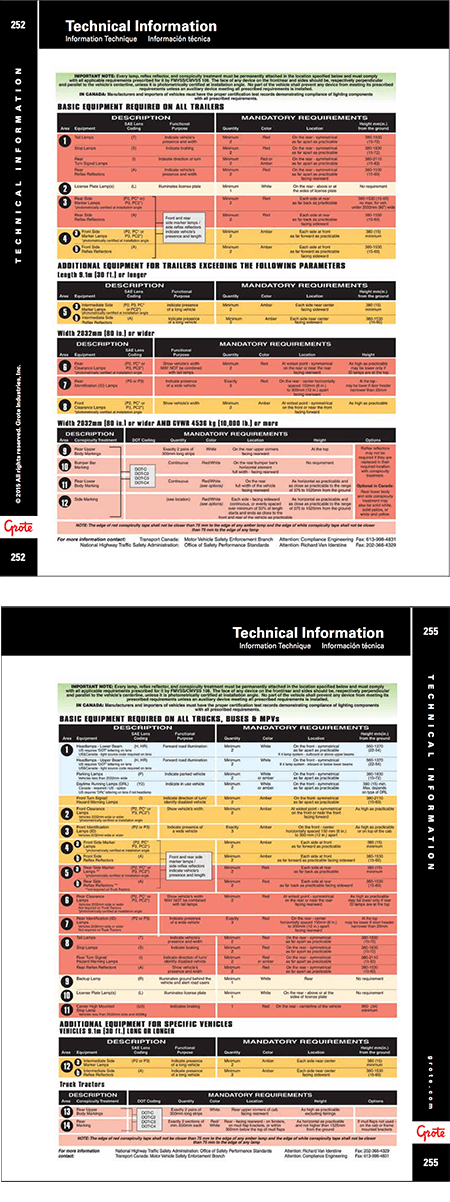
The Technical Information section of the Grote Reference Guide contains charts based on the FMVSS-108 standard which specifies the performance requirements, numbers and locations of lights on vehicles.
The chart is based upon a grid. The information reading left to right across describes the equipment and the mandatory quantities and other requirements. Reading from top to bottom, the chart shows the requirements beginning with what is required for all trailers in the top section. Additional requirements are triggered as a trailer’s size and weight increase. Those requirements are detailed in sections of the chart below the basic requirements toward the bottom of the chart. Keep in mind that the basic requirements are fixed and that larger and heavier means adding more equipment.
A closer look at a typical line in the top section titled “Basic Equipment Required On All Trailers” section will help illustrate the information layout on the chart. One way of learning how the system works is to assume that a trailer has no lights and the task is to determine what the requirements are.
The first column in the “Description” section describes the type of equipment. In this example, “Tail Lamps,” corresponds to the product descriptions used in Grote Reference Guides and other resources. The third column describes the purpose that the device has and the roll it plays in the lighting system. In this case, it is to indicate the trailer’s presence and width.
Between those two columns, there is a third that lists a code that is molded into quality lenses. It refers to the designation established to describe the function of lighting devices by the Society of Automotive Engineers (SAE) an industry professional group. The value of the permanent reference is that it helps avoid mix-ups where two devices may, at a glance, appear similar, but not function the same. The three ways of describing devices are the same throughout the top three sections of the chart on the trailer page.
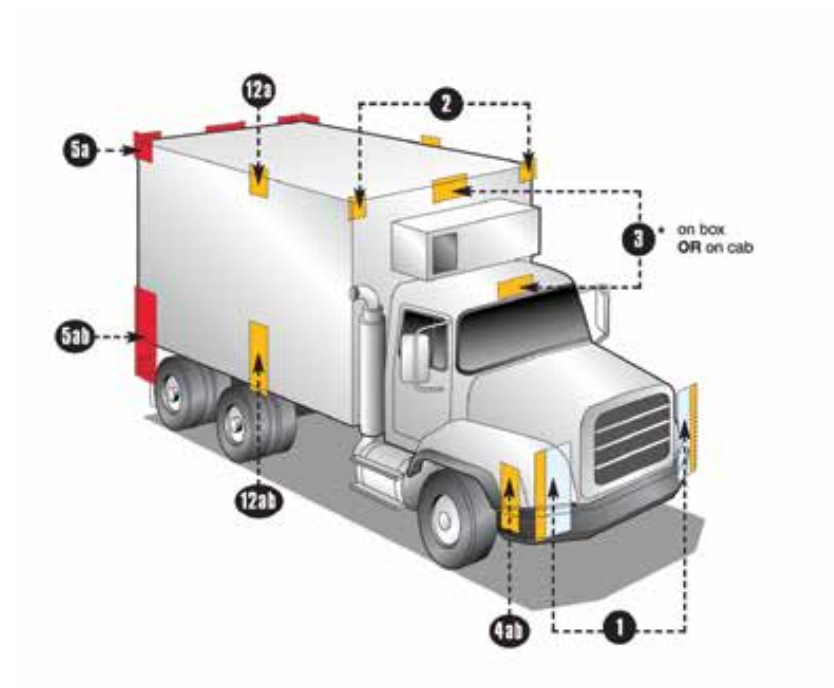
The “Mandatory Requirements” section provides information about how to use the devices identified in the “Description” section. Under “Mandatory Requirements” on the chart, the first column tells how many are required, the second, which colors are allowed, third, the location on the trailer body and fourth how high they shall be installed.
Reading across the seven columns shows the exact stop light requirements for basic trailer tail lamp installations under the provisions of FMVSS-108. Simply using the same approach for the remaining equipment would offer a comprehensive picture of the other required equipment.
If a trailer is longer or wider, the chart offers sections below the basic equipment part for trailers 30 feet or longer and/or 80 inches wide or wider.
Another section of the chart is devoted to requirements of trailers that are 80 inches and wider as well as 10,000 pounds or greater in weight. These requirements are shown in a slightly different but similar format.
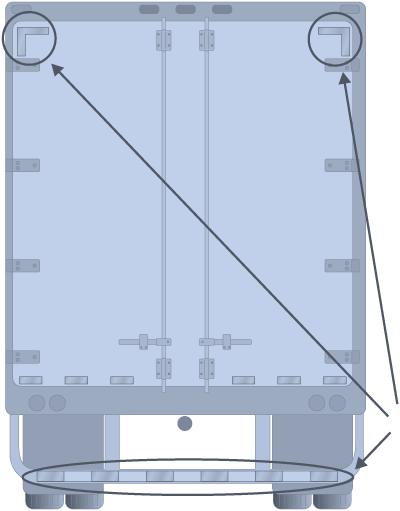
Conspicuity tape provides a bright reflective surface to enhance the visibility of a truck, making it more conspicuous to other drivers.
These requirements refer to the application of “conspicuity tape.” It is highly reflective strips of alternating color adhesive material used to make a trailer more easily seen, especially after dark. It is used along with electric lights to add to the vehicle’s conspicuity.
In the conspicuity section there is a “description” section as well as a “mandatory requirements” section, which calls out the Department of Transportation (DOT) code for the tape locations and the quantity of material to be used. The other columns indicate color, location, height and any options involved in the application.
To help the visualization process, a location drawing at the bottom provides a visual resource for all of the equipment including conspicuity tape. It shows the locations described above and calls out the specific location by number and letter.
The same process is used to determine requirements for use of lighting and conspicuity markings on trucks and truck tractors to meet the requirements of FMVSS-108.
The practical use of the chart really becomes obvious in situations where a customer needs a replacement for a missing or damaged device … for example, a stop lamp.
Find the equipment description for stop lamp in the right hand column of the Basic Equipment section of the trucks and buses chart. Read across to find the SAE lamp code (as a cross check with the suggested replacement), and confirm that the description in the Functional Purpose column
matches the mission. In this case, it says “Indicate Braking,” which is correct.
The “Quantity” column indicates that there needs to be at least two, and the “Color” column indicates red which matches the existing equipment.
To finish the process, double check that the location and positioning shown on the chart match the current situation.
Use the self assessment below to gauge your understanding of this section. Place your answer in the box and then check your answer by clicking on the "show answer" link.
Or, you can skip the assessment.
Instructions:
Read the question.
Place your answer in the box.
Example:
True or False:
You should read the questions and then type your answer into the box.
show answer
True!
Begin:
1. True or False: The earliest vehicle lights were crude incandescent bulbs.
show answer
False
2. True or False: Carbon arc lamps need little or no maintenance.
show answer
False
3. True or False: The use of red tail and yellow brake lights began in 1915.
show answer
True
4. The use of sealed-beam headlights began in:
show answer
c) 1938
5. True or False: The first dual filament headlight was called the "Duplo."
show answer
True
6. Sealed beam headlights typically
show answer
b) Must be replaced if the filament fails
7. Compared to incandescents, halogen headlights
show answer
8. True or False: Dual filament halogen headlights are used in most cars.
show answer
True
9. True or False: In 1975, the DOT allowed the use of rectangular and non-standard shape lamps.
show answer
False
10. True or False: The term “HIR” stands for High Intensity Recharge lights
show answer
False
11. True or False: HIR lights have a coating on the inside, which reflects ultra-violet light back to the filament for more intense light output.
show answer
False
12. HID lighting is different from halogen because it
show answer
d) All of the above
13. True or False: When a HID lamp fails there is a bright flash.
show answer
False
14. An incandescent bulb is made up of all but what component?
show answer
d) Arc tube
Incandescent bulbs are inefficient and waste % of the energy flow- ing through them as heat.
show answer
c) 95
True or False: Incandescent bulbs are filled with oxygen to make them burn brighter.
show answer
False
17. True or False: Incandescent bulbs are sensitive to voltage levels. Operating one at just 5% more than design voltage can reduce bulb life by 44%.
show answer
True
18. True or False: “LED” stands for Light-Extracting Diode.
show answer
False
True or False: LEDs can produce light in many different colors.
show answer
c) True
20. True or False: Sealing LED circuit boards is called “potting.”
show answer
True
21. A drawback to using LED’s on vehicles is that they are sensitive to vibration.
show answer
False
22. The main set of rules that govern truck and trailer lighting comes from
show answer
a) NHTSA
23.On the FMVSS-108 chart, which of the following is not specified
show answer
c) Wattage of light
24. True or False: Under the “Basic Equipment Required On All Trailers,” a minimum of two reflectors is required on the rear.
show answer
True
25. True or False: For a trailer over 80 inches, three rear identification lamps are required.
show answer
True
26. On a 29 foot trailer, how many intermediate side marker lamps are required?
show answer
d) None of the above
27. True or False: According to FMVSS-108, license plate lights must me mounted above the plate.
show answer
False
28. True or False: On an 80 inch wide trailer, the rear clearance lamps are often combined with tail lamps to save space.
show answer
False
29. True or False: When applying conspicuity tape on the side of a trailer, it must cover at least 50% of the length of the trailer.
show answer
True